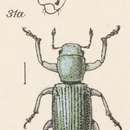Description
provided by INOTAXA archive
Head very large, broad, convex; mentum small, not covering the maxillæ rostrum strongly transverse, deeply, triangularly emarginate at the sides and apex, the scrobes rather short, angulate, distant from the eyes, the latter small and rounded; antennal scape reaching to the middle of the eyes, the funiculus 7-jointed, joints 2—7 short; vibrissæ well-developed; anterior coxæ contiguous; anterior femora feebly clavate, not longer than the others; anterior tibiæ unguiculate at the apex, not or obsoletely denticulate; tarsal claws free; body robust, winged, densely clothed with scales.
- license
- cc-by-3.0
- copyright
- Biologia Centrali-Americana
Physical description
provided by INOTAXA archive
The type of this genus was provisionally referred to Pandeleteius by Schaeffer, but it must certainly be removed therefrom, differing as it does in numerous points of structure. The head is greatly developed, recalling that of Elissa and various other genera of the “Series Apteræ
”; the prothorax is somewhat cup-shaped; and the elytra are broader than the prothorax, comparatively short and subparallel, and finely punctate-striate. The insect is found on juniper, according to Mr. Wickham.
- license
- cc-by-3.0
- copyright
- Biologia Centrali-Americana

